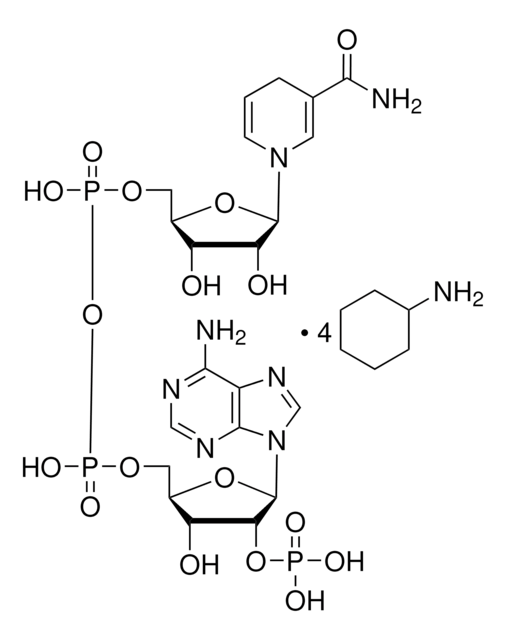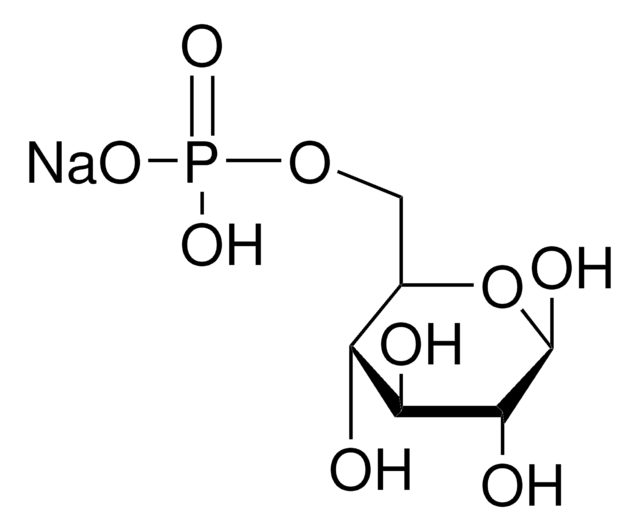F0628
Ferredoxin-NADP+ Reductase from Spinacia oleracea (spinach)
lyophilized powder, ≥15 units/mg solid, secondary activity: ≥10 units/mg solid NADPH diaphorase
Sinônimo(s):
Ferridoxin-NADP+ oxidoreductase
Faça loginpara ver os preços organizacionais e de contrato
About This Item
Número CAS:
Número MDL:
Código UNSPSC:
12352204
NACRES:
NA.54
Produtos recomendados
forma
lyophilized powder
Nível de qualidade
atividade específica
≥15 units/mg solid
atividade externa
NADH diaphorase activity ≤10 units/mg solid
temperatura de armazenamento
−20°C
Descrição geral
Ferredoxin-NADP+ Reductase is a ferredoxin-soluble partner with a molar ratio to PSI of 0.9 and 3.
Aplicação
Ferredoxin-NADP+ Reductase from Spinacia oleracea (spinach) has been used to test the effect of potential protein partners on the activity of the glyceraldehyde-3-phosphate dehydrogenase (GAPDH)−CP12 preparation. It has also been used in standard assay conditions for phycocyanobilin:ferredoxin oxidoreductase (PcyA) enzyme assay.
Ferredoxin-NADP+ Reductase was used in in vitro ferredoxin-dependent desaturation of fatty acids in cyanobacterial thylakoid membranes. It was also used to regulate glyceraldehyde-3-phosphate dehydrogenase.
Ações bioquímicas/fisiológicas
Ferredoxin-NADP+ reductase catalyzes the reversible conversion of reduced ferredoxin to oxidized ferredoxin during photosynthesis. Ferredoxin-NADP(H) reductase constitutes a family of hydrophilic FAD-containing monomeric enzymes that deliver NADPH or low potential one-electron donors to redox-based metabolisms in plastids, mitochondria, and bacteria.
Ferredoxin-NADP+ reductase catalyzes the reversible conversion of reduced ferredoxin to oxidized ferredoxin during photosynthesis. Ferredoxin-NADP(H) reductase constitutes a family of hydrophilic FAD-containing monomeric enzymes that deliver NADPH or low potential one-electron donors to redox-based metabolisms in plastids, mitochondria, and bacteria.
Definição da unidade
One unit will reduce 1.0 millimole of cytochrome C per min at pH 7.5 at 25 °C in the presence of spinach ferredoxin and NADP.
Código de classe de armazenamento
11 - Combustible Solids
Classe de risco de água (WGK)
WGK 3
Ponto de fulgor (°F)
Not applicable
Ponto de fulgor (°C)
Not applicable
Equipamento de proteção individual
Eyeshields, Gloves, type N95 (US)
Certificados de análise (COA)
Busque Certificados de análise (COA) digitando o Número do Lote do produto. Os números de lote e remessa podem ser encontrados no rótulo de um produto após a palavra “Lot” ou “Batch”.
Já possui este produto?
Encontre a documentação dos produtos que você adquiriu recentemente na biblioteca de documentos.
Os clientes também visualizaram
A Conserved Histidine-Aspartate Pair Is Required for Exovinyl Reduction of Biliverdin by a Cyanobacterial Phycocyanobilin:Ferredoxin Oxidoreductase
Tu SL, et al.
The Journal of Biological Chemistry, 281(6), 3127-3136 (2006)
Néstor Carrillo et al.
European journal of biochemistry, 270(9), 1900-1915 (2003-04-24)
Ferredoxin (flavodoxin)-NADP(H) reductases (FNR) are ubiquitous flavoenzymes that deliver NADPH or low potential one-electron donors (ferredoxin, flavodoxin) to redox-based metabolisms in plastids, mitochondria and bacteria. The plant-type reductase is also the basic prototype for one of the major families of
Glyceraldehyde-3-phosphate dehydrogenase is regulated by ferredoxin-NADP reductase in the diatom Asterionella formosa
Mekhalfi M, et al.
The New phytologist, 203, 414-423 (2014)
Ferredoxin-NADP+ Reductase KINETICS OF ELECTRON TRANSFER, TRANSIENT INTERMEDIATES, AND CATALYTIC ACTIVITIES STUDIED BY FLASH-ABSORPTION SPECTROSCOPY WITH ISOLATED PHOTOSYSTEM I AND FERREDOXIN
Cassan N, et al.
The Journal of Biological Chemistry, 280(28), 25960-25972 (2005)
Min Seok Cho et al.
Journal of microbiology (Seoul, Korea), 50(3), 496-501 (2012-07-04)
The Gram-positive bacterium Clavibacter michiganensis subsp. michiganensis is the causal agent of canker disease in tomato. Because it is very important to control newly introduced inoculum sources from commercial materials, the specific detection of this pathogen in seeds and seedlings
Nossa equipe de cientistas tem experiência em todas as áreas de pesquisa, incluindo Life Sciences, ciência de materiais, síntese química, cromatografia, química analítica e muitas outras.
Entre em contato com a assistência técnica











